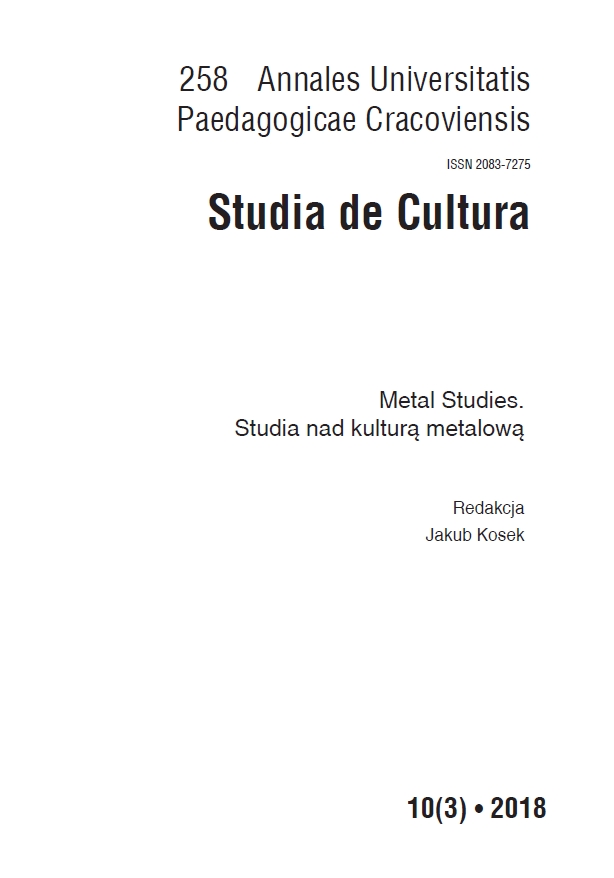Abstract
DOI 10.24917/20837275.10.3.10
W niniejszym artykule autorka zarysowuje cechy charakterystyczne japońskiego metaluw kolejnych dekadach jego rozwoju, co następuje poprzez przedstawienie twórczościwybranych zespołów, działalności fanów oraz wskazanie źródeł inspiracji artystów. Istotnymelementem zaprezentowanej analizy jest rozwój zjawisk kulturowych towarzyszącychprzemianom muzyki metalowej, takich jak subkultury zoku czy estetyka visual kei.Wychodząc od wpływu rockabilly, inspirowanego twórczością zachodnią, na pojawienie sięmuzyki rockowej, a potem metalowej, autorka pokazuje kierunki rozwoju gatunku, sytuującje w szerszej perspektywie przemian japońskiego przemysłu muzycznego.
Metal in the shade of a blooming cherry. The specificity and transformationof the genre on the basis of Japanese
In the presented article the author depicts the distinctive features of the Japanese metalmusic in the different decades of its development, what she accomplishes through showingthe achievements of the chosen artists. She also focuses on pointing out the primary sourcesof their inspirations that influenced the described genre. The significant part of the presentedanalysis in the development of the cultural phenomena accompanying the development of themusic - such as zoku sub-cultures and visual kei aesthetic. Starting from the rockabilly musicthat influenced Japan in the 60s and contributed to rock and metal music, the author depictsthe ways of development of the metal genre, situating them in the broader perspective of thechanges in the Japanese music industry.
References
Aoki Ryotaro. 2015. “Gesu Tapped into the 2015 ‘band boom’”. The Japan Times http://www.japantimes.co.jp/culture/2015/12/06/music/gesu-tapped-2015-band-boom/#.VxlX_EcoN8j [dostęp: 5.01.2016].
View in Google Scholar
Aaron Charles. 2014. “X Japan’s Incredible Ride: Meet Rock’s Most Flamboyant Survivors”.
View in Google Scholar
Rolling Stone. http://www.rollingstone.com/music/features/x-japans-incredible-ride-meet-rocks-most-flamboyant-survivors-20141010 [dostęp: 7.01.2016].
View in Google Scholar
Adamowicz Klaudia. 2014. Wizerunek mężczyzny w visual kei. Bielsko-Biała.
View in Google Scholar
Ashcraft Brian. 2016. “Watch Babymetal’s U.S. Television Debut Right Here”. http://kotaku.com/watch-babymetals-u-s-television-debut-right-here-1769322306 [dostęp: 15.09.2017].
View in Google Scholar
B.a. 2017. 1. „聖飢魔II”. http://www.seikima-ii.com/top.html [dostęp: 20.10.2017]. (oficjalna strona zespołu).
View in Google Scholar
B.a. 2017. 2. „44 Magnum Official Website”. http://www.44magnum2001.com/ [dostęp: 17.10.2017]. (oficjalna strona zespołu).
View in Google Scholar
B.a. 2017. 3. “Loudness”. http://www.loudnessjp.com/en/history/ [dostęp: 18.10.2017]. (oficjalna strona zespołu).
View in Google Scholar
B.a. 2017. 4. “Sex Machineguns Official Site”. http://sexmachineguns.smg-fire.com/top [dostęp: 17. 10. 2017] (oficjalna strona zespołu).
View in Google Scholar
B.a. 2017. 5. “Show-Ya”. http://show-ya.jp/ [dostęp: 19. 10. 2017]. (oficjalna strona zespołu).
View in Google Scholar
Bourdaghs Michael. 2012. Sayonara Amerika, Sayonara Nippon: A Geopolitical Prehistory of J-Pop. Nowy Jork.
View in Google Scholar
Buckley Sandra. 2009. The Encyclopedia of Contemporary Japanese Culture. London–New York.
View in Google Scholar
Cameron Don. 2000. “Off-the-Rack Identities: Japanese Street Fashion Magazines and the Commodification of Style”. Japanese Studies Vol. 20, nr 2. 179–187.
View in Google Scholar
Chen Nick. 2017. “Sects, suicide & speed metal: the unreal story of X Japan”. http://www.dazeddigital.com/music/article/34948/1/x-japan-we-are-x-speedmetal-band-davidlynch [dostęp: 5.10.2017].
View in Google Scholar
Fuchs Otto. 2011. Bill Haley. The Father Of Rock & Roll. Gelnhausen.
View in Google Scholar
Hołyst Brunon. 1994. Japonia. Przestępczość na marginesie cywilizacji. Warszawa.
View in Google Scholar
Kawano Kei, Hosokawa Shuhei. 2012. Thunder in the Far East: the Heavy Metal industry in 1990s Japan. W Metal Rules the Globe: Heavy Metal Music Around the World. J. Wallach, H.M. Berger, P.D. Greene Durham (red.). 247–267.
View in Google Scholar
Kegan Yrjänä. 2014. Subgenres of the Beast: A Heavy Metal Guide. Raleigh.
View in Google Scholar
Kiejziewicz Agnieszka. 2016. Visual kei i inne strategie performatywne. Przemiany japońskiego rocka w latach 1980–2015 W Kultura rocka 2. Słowo – dźwięk – performance. J. Osiński, M. Pranke, P. Tański (red.). Toruń. 155–165.
View in Google Scholar
Larkin Colin. 1995. The Guinness Encyclopedia of Popular Music, tom 2, Ann Arbor.
View in Google Scholar
Martin Ian. 2008. “Naon no Yaon”. The Japan Times. https://www.japantimes.co.jp/culture/2008/04/18/music/concert-previews/naon-no-yaon/#.VBCE0aOHPHQ [dostęp: 12.102017].
View in Google Scholar
Matsue Jennifer. 2015. Focus: Music in Contemporary Japan. New York.
View in Google Scholar
Mattar Yasser. 2009. “Miso Soup for the Ears: Contemporary Japanese Popular Music and its Relation to the Genres Familiar to the Anglophonic Audience”. Popular Music and Society Vol. 31, nr 1. 113–123.
View in Google Scholar
McLeod K. 2013. “Visual Kei: Hybridity and Gender in Japanese Popular Culture”. Young nr 21(4). 309–325.
View in Google Scholar
Minamida Katsuya. 2014. The Development of Japanese Rock. A Bourdieuan Analysis. W Made in Japan. Studies in Popular Music. M. Tori (red.). London. 120–131.
View in Google Scholar
Moore Ryan. 2010. Sells Like Teen Spirit: Music, Youth Culture, and Social Crisis. London.
View in Google Scholar
Phro Preston. 2014. “A brief history of Japanese rockabilly: Not just for your grandparents”. Japan Today. https://japantoday.com/category/features/a-brief-history-of-japanese-rockabilly-not-just-for-your-grandparents [dostęp: 20.10.2017].
View in Google Scholar
Plourde Lorraine. 2016. “Babymetal and the ambivalence of cuteness”. International Journal of Cultural Studies. https://doi.org/10.1177/1367877916674741 [dostęp: 15.10.2017].
View in Google Scholar
Sato Ikuya. 1998. Kamikaze Biker: Parody and Anomy in Affluent Japan. Chicago.
View in Google Scholar
Shimizu Tōru. 2014. From Covers to Originals: “Rockabilly” in 1956–1963. W Made in Japan.
View in Google Scholar
Studies in Popular Music. M. Tori (red.). New York–London. 103–119.
View in Google Scholar
Stevens Carolyn. 2012. Japanese Popular Music: Culture, Authenticity and Power. London–New York.
View in Google Scholar
West Dawid. 2015. “Remembering The Original Japanese Rock Invasion”. Team Rock. http://teamrock.com/feature/2015-01-24/remembering-the-original-japanese-rock-invasion [dostęp: 15.10.2017].
View in Google Scholar
Whyte Wilson. 2009. “Kyoji Yamamoto leaves all inhibitions behind. Rocker breaks free of cultural bonds to jam with the world’s best”. The Japan Times. http://www.japantimes.co.jp/text/fl20090418a1.html [dostęp: 20.10.2017].
View in Google Scholar

